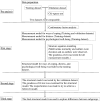Coping strategies and distress reduction in psychological well-being? A structural equation modelling analysis using a national population sample
- PMID: 26077164
- PMCID: PMC7137609
- DOI: 10.1017/S2045796015000505
Coping strategies and distress reduction in psychological well-being? A structural equation modelling analysis using a national population sample
Abstract
Background: Little is understood about of the role of coping strategies in psychological well-being (PWB) and distress for the general population and different physical and psychiatric disease groups. A thorough examination of these relationships may provide evidence for the implementation of public mental health promotion and psychiatric disease prevention strategies aimed at improving the use of positive coping approaches or addressing the causes and maintainers of distress. The present study using a structural equation modelling (SEM) approach and nationally representative data on the Canadian population investigates the relationships among PWB, distress and coping strategies and identifies major factors related to PWB for both the general population and diverse-specific disease groups.
Methods: Data examined were from the Canadian Community Health Survey of Mental Health and Well-being (CCHS 1.2), a large national survey (n = 36 984). We applied exploratory factor analysis (EFA), confirmatory factor analysis and SEM to build structural relationships among PWB, distress and coping strategies in the general population.
Results: Both SEM measurement and structure models provided a good fit. Distress was positively related to negative coping and negatively related to positive coping. Positive coping indicated a higher level of PWB, whereas negative coping was associated with a lower level of PWB. PWB was negatively related to distress. These same relationships were also found in the population subgroups. For the population with diseases (both physical and psychiatric diseases, except agoraphobia), distress was the more important factor determining subjective PWB than the person's coping strategies, whereas, negative coping had a major impact on distress in the general population. Strengths and limitations were also discussed.
Conclusions: Our findings have practical implications for public psychiatric disease intervention and mental health promotion. As previously noted positive/adaptive coping increased the level of PWB, whereas negative/maladaptive coping was positively related to distress and negatively related to PWB. Distress decreased the level of PWB. Our findings identified major correlates of PWB in both the general population and population subgroups. Our results provide evidence for the differential use of intervention tactics among different target audiences. In order to improve the mental health of the general population public mental health promotion should focus on strategies that reduce negative coping at a population level, whereas clinicians treating individual clients should make the reduction of distress their primary target to maintain or improve patients' PWB.
Keywords: Epidemiology; factor analysis; mental health; psychiatric services; stress.
Figures


Similar articles
-
Social Support and Positive Coping Skills as Mediators Buffering the Impact of Childhood Maltreatment on Psychological Distress and Positive Mental Health in Adulthood: Analysis of a National Population-Based Sample.Am J Epidemiol. 2020 May 5;189(5):394-402. doi: 10.1093/aje/kwz275. Am J Epidemiol. 2020. PMID: 31907548
-
Psychological well-being and its associations with sociodemographic characteristics, physical health, substance use and other mental health outcomes among adults in Canada.Health Promot Chronic Dis Prev Can. 2024 Oct;44(10):431-439. doi: 10.24095/hpcdp.44.9.03. Health Promot Chronic Dis Prev Can. 2024. PMID: 39388294 Free PMC article.
-
Physical activity and social support mediate the relationship between chronic diseases and positive mental health in a national sample of community-dwelling Canadians 65+: A structural equation analysis.J Affect Disord. 2022 Feb 1;298(Pt A):142-150. doi: 10.1016/j.jad.2021.10.055. Epub 2021 Oct 30. J Affect Disord. 2022. PMID: 34728294
-
Psychological well-being as part of the public health debate? Insight into dimensions, interventions, and policy.BMC Public Health. 2019 Dec 19;19(1):1712. doi: 10.1186/s12889-019-8029-x. BMC Public Health. 2019. PMID: 31856772 Free PMC article. Review.
-
Coping as a mediator between locus of control, competence beliefs, and mental health: A systematic review and structural equation modelling meta-analysis.Behav Res Ther. 2019 Oct;121:103442. doi: 10.1016/j.brat.2019.103442. Epub 2019 Jul 23. Behav Res Ther. 2019. PMID: 31430689
Cited by
-
The Association of the Health Management Strategy with Subjective Health and Well-being Outcomes in General Population.J Korean Med Sci. 2021 Dec 27;36(50):e340. doi: 10.3346/jkms.2021.36.e340. J Korean Med Sci. 2021. PMID: 34962113 Free PMC article.
-
Work routines moderate the association between eveningness and poor psychological well-being.PLoS One. 2018 Apr 6;13(4):e0195078. doi: 10.1371/journal.pone.0195078. eCollection 2018. PLoS One. 2018. PMID: 29624593 Free PMC article.
-
Coping and positive mental health in Canada among youth and adults: findings from a population-based nationally representative survey.Health Promot Chronic Dis Prev Can. 2025 May;45(5):238-248. doi: 10.24095/hpcdp.45.5.02. Health Promot Chronic Dis Prev Can. 2025. PMID: 40402136 Free PMC article.
-
The Emotions, Coping, and Psychological Well-Being in Time of COVID-19: Case of Master's Students.Int J Environ Res Public Health. 2022 May 15;19(10):6014. doi: 10.3390/ijerph19106014. Int J Environ Res Public Health. 2022. PMID: 35627550 Free PMC article.
-
Adolescer in Time of COVID-19's Pandemic: Rationale and Construction Process of a Digital Intervention to Promote Adolescents' Positive Development.Int J Environ Res Public Health. 2022 Feb 22;19(5):2536. doi: 10.3390/ijerph19052536. Int J Environ Res Public Health. 2022. PMID: 35270229 Free PMC article.
References
-
- Alexander CN, Rainforth MV, Gelderloos P (1991). Transcendental meditation, self-actualization, and psychological health: a conceptual overview and statistical meta-analysis. Journal of Social Behavior and Personality 6, 189–247.
-
- Amirkhan JH (1990). A factor analytically derived measure of coping: the coping strategy indicator. Journal of Personality and Social Psychology 59, 1066–1074.
-
- Arbuckle JL (2006). Amos (Version 7.0) [Computer Program]. Chicago: SPSS patent application.
-
- Bentler PM (1990). Comparative fit indexes in structural models. Psychological Bulletin 107, 238–246. - PubMed
-
- Billings DW, Folkman S, Acree M, Moskowitz JT (2000). Coping and physical health during caregiving: the roles of positive and negative effect. Journal of Personality and Social Psychology 79, 131–142. - PubMed
MeSH terms
LinkOut - more resources
Full Text Sources
Medical
Research Materials

